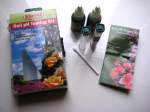Home › Garden lawns › Lawn grasses
Lawn Grasses
Choosing The Best Varieties
If you are starting a new lawn, or even replacing an old one, you will be faced with a choice of lawn grasses, either in the form of lawn seed mixes or ready-to-lay turf.
Each mixture of grass species and varieties has different properties.
So how do you choose the right one?
The best mix of lawn grasses depends on three things: the type of lawn you want, whether you live in a temperate or warm climatic zone, and whether you are trying to establish a lawn in less than ideal conditions such as a shady site.
Broadly speaking, there are two types of lawn that you can choose from: a formal, high-quality lawn or a tougher, more practical, utility lawn.
To decide between these two options, you will need to assess the relative importance of appearance, resistance to wear, and lawn maintenance needs.
Once you have come to a decision, buy lawn seed or turf containing the correct mixture of lawn grasses.
Lawn Grasses for High Quality Lawns
If a perfect appearance is of prime importance, you do not anticipate very heavy wear, and you will enjoy carrying out a regular maintenance programme, a high quality lawn is the best choice.
Temperate Zones
In temperate regions, the finest lawns are produced by a mixture of bents (Agrostis) and fescues (Festuca) which are fine leaved, low growing grasses that tolerate close mowing. They produce a dense velvety lawn with an even texture and colour.
Warm Zones
In warm climatic zones, cultivars of Bermuda grass (Cynodon) produce a high quality lawn. The slower growing zoysia grasses (Zoysia) are also suitable.
Lawn Grasses for Utility Lawns
Utility lawns are probably a more practical choice for most of us as they provide a hardwearing and safe surface for children's games and outdoor entertaining whilst still looking attractive. They also require a less rigorous maintenance regime than high quality lawns.
Temperate Zones
In temperate zones, utility mixtures contain a high proportion of perennial rye grass (Lolium perenne) for its toughness and resistance to wear.
Fescues (Festuca), smooth-stalked meadow grass (Poa pratensis), which is also known as Kentucky blue grass, and bents (Agrostis) are added to improve the appearance.
Warm Zones
In warm climatic regions the Bermuda grasses (Cynodon), which are also used for high quality lawns, will withstand heavy wear but need frequent mowing.
If you prefer a lower maintenance lawn you can choose bahia grass (Paspalum notatum), carpet grass (Axonopus) or centipede grass (Eremochloa ophiuroides), although these have a rather coarser texture.
Lawn Grasses for Problem Areas
If you have a difficult site, but are determined to have a lawn, you can buy grass mixtures that are designed to grow in less than ideal conditions. However, in these circumstances, it is unrealistic to expect a very high quality result.
Temperate Zones
In temperate regions wood meadow grass (Poa nemoralis) and rough-stalked meadow grass (Poa trivialis) can be used, together with fescues (Festuca), in wet shady areas.
For very dry areas, western wheatgrass (Agropyron smithii) or fairway crested wheatgrass (Agropyron cristatum) are possible choices.
Warm Zones
In warm regions St Augustine grass (Stenotaphrum secundatum) will tolerate both shade and coastal sites.
Buying Grass Seed and Turf
Reputable retailers of lawn seed and suppliers of turf should have products that are suitable for a range of lawn types and a variety of growing conditions.
Use the information above as a guide and ask questions to make certain that you are getting the right product for your needs.
Be prepared to spend a little more if necessary - after all, a garden lawn lasts for many years and it is worth getting it right from the start.
Need More Information?
You will find more information about garden lawns, together with links to other lawn-related pages, at garden lawns.
Home › Garden lawns › Lawn grasses
